Our
BLOG:
"Food For Thought"
May 5, 2015
Educating the Senses (Part 1)
If you know nothing else about the Montessori approach to education you probably know it has to do with the senses of touch, seeing, hearing, and so forth. But where did Maria Montessori get these ideas and how did she know how to put them into action? It turns out that she borrowed some things and cleverly created others.
Maria Montessori developed her approach to educating very young children in the early 20th Century. Compared to today, science was a new idea, especially in education. It had revolutionized the study of physics, was enabling great advances in medicine (Montessori was a medical doctor), biology and psychology. As science became professionalized and institutionalized it produced inspiring insights and valuable discoveries. Now it was time for it to be applied to improving education.
Montessori welcomed the objectivity that science promised, and the emphasis on careful observation and collection of factual information. Properly used, the scientific approach should allow educators to put aside false beliefs inherited from the past and to find out what really works and why.
But Montessori was not convinced that precise quantification and statistical calculations would actually lead to better teaching. Teachers certainly must not treat children in the aloof, impersonal, strictly controlled manner that scientists are trained to use. She would not make the mistake of confusing the experimental study of the pupil with his education.
Still, some of the psycho-physical procedures used by German psychologists of her day seemed useful. From them she took the nine qualities of any object (shape, color, texture, sound, smell, taste, temperature, weight, size) and developed materials (such as cylinder blocks, color boxes, sound cylinders) that even the youngest children can explore.
It must have required a lot of effort to work out the best design of the materials and how best to present them to very young children. We will see in the next blog post what she came up with.
(References: Ahlquist, Eva-Marie
(2011). Between science and politics. Conference paper, Stockholm
University, Institution of Education.
Montessori, Maria (1912). The Montessori Method: Scientific Pedagogy as
Applied to Child Education
Sharmila (2009), Sensorial Study Through Senses.)
March 20, 2015
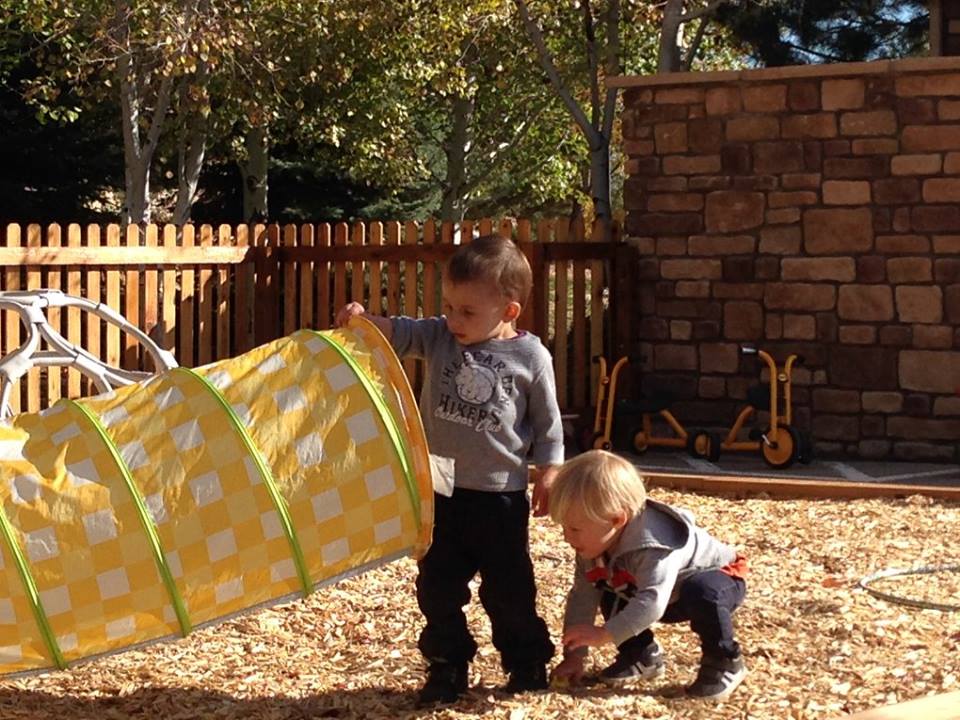
Quality Care and the Very Young
As you may be well aware, the higher the education level of parents, the more likely they are to be employed. Despite a small increase in the number of stay-at-home parents in the U.S. during the last few years, and also the growth in opportunities to work-at-home, most children today have both mothers and fathers working at jobs elsewhere. The result is that half of children under 5 years of age are taken care of outside the home.
At the same time this is happening, current research describes how brain synapses form at a colossal rate in the earliest years of a child's life. Some people will insist that if the young child is simply kept warm, dry, fed and safely entertained, those synapses will take care of themselves. When you consider conditions ten thousand years ago, maybe that's progress. But now we know so much more about early development.
The people entrusted to care for all these children can positively impact how those synapses form and connect. This is one reason Maria Montessori's findings are considered so important that the people, the environment, and the materials with which an infant or toddler interacts are of extraordinary significance.
(References: National Baby Facts, Zero to Three http://www.zerotothree.org/public-policy/pdf/national-baby-facts.pdf; America's Children in Brief, Federal Interagency Forum on Child and Family Statistics http://www.childstats.gov/pdf/ac2012/ac_12.pdf; After Decades of Decline, A Rise in Stay-at-Home Mothers, Pew Research Center http://www.pewsocialtrends.org/2014/04/08/after-decades-of-decline-a-rise-in-stay-at-home-mothers/.
Furniture in the Classroom
A school loyal to the same educational principles of respect for the freedom of the child... principles which shall form the personality. Maria Montessori
Sometimes people ask whether the furniture at Heart and Hands is made especially for a Montessori school. We ordered virtually all of our furniture from companies specializing in the kinds of things inspired by what Maria Montessori had in her Children's Houses of the early 1900s. If that sounds old fashioned, it's not.
Montessori wanted to encourage the very youngest children to move about on their own, to be able to reach things they are interested in, work with materials easily, and be as independent as possible.
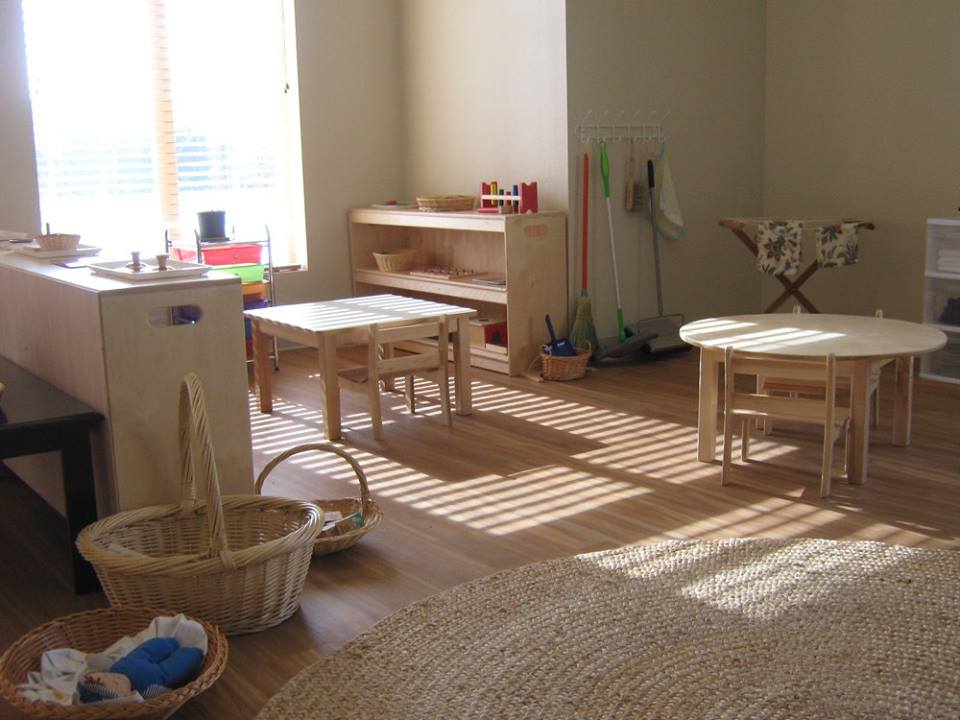 So
the furniture is light in color - useful without being a distraction.
Mostly made of wood. Shelves are low so materials are easily visible.
Coat hooks and cubbies at the children's level so they can learn to hang
up and take down their belongings.
So
the furniture is light in color - useful without being a distraction.
Mostly made of wood. Shelves are low so materials are easily visible.
Coat hooks and cubbies at the children's level so they can learn to hang
up and take down their belongings.
Infants have the first chair low, heavy and very stable so it won't tip even when climbed on without adult aid. Toddlers have lighter, low chairs with broad bases built so they can lift and move them with ease. The experienced eye of the teacher sees when intervention would really help. Most of the time the furniture comforts the children and enables them to proceed on their own.
Today you will find some of these features incorporated into furniture used by all sorts of infant and toddler centers. Some of the features, but by no means all. Montessori was very clear about the kind of independence she was looking for and what it would bring. Muscle coordination and agility, confidence to move unrestrained. Freedom to explore, to get something oneself and not be handed it by an adult. To make those early decisions about what to approach or avoid based on one's own interests and readiness. Feeling motivated but not over-stimulated.
(Reference: Montessori, M. (1912). The Montessori Method: Scientific Pedagogy As Applied To Child Education In "The Children's Houses" With Additions And Revisions By The Author. New York: Frederick A. Stokes Company MCMXII http://digital.library.upenn.edu/women/montessori/method/method.html)
Imitative Learning
Imitation is the first instinct of the awakening mind. Maria Montessori
Let's not forget how much infants learn by imitation. They readily pick up a toy telephone and pretend to talk with it because they see us talking on our phones. They repeat the sounds of their native language because they hear others speaking, and mimic jingles they hear on television.
This imitation happens from a very early age throughout various developmental stages, and it doesn't have to be taught, deliberately encouraged or rewarded. The human brain deftly tunes in to what others are doing through a network of "mirror" regions in the brain that activate almost identically when performing a certain act as when seeing another person perform it. See someone smiling? The parts of the brain that you use to smile (and your baby's) spontaneously activate. Not only does one learn about what is seen, but also, in a way, one experiences it and understands it from inside.
Babies not only imitate what their family members do at home but also their peers in day care or at play. For example, they will often mimic the way infants of their same age manipulate toys. When very young children copy what they see or hear you will often observe that they smile and laugh and seem very satisfied without any praise or approval from us. This internal gratification is so very valuable.
When babies imitate they don't just repeat the most obvious behavior they see or hear, but they seem to understand the aim or intent. They tend not to imitate the errors or slip-ups, but learn instead the completed sequence. If you show a baby how to push a ball across the floor to another person, but when you do it you accidentally misdirect the ball, the child is unlikely to copy your mistake.
Babies begin to sense what we mean to do even if we fail to do it. Studies show that infants learn to pull a cap off the end of a stick after watching an adult trying to do this but (deliberately) letting his hands slip, failing again and again. The children never see it done right but most of the time will pull the cap off successfully when given the chance themselves. They accurately infer the goal of the action even though they don't see it done. They get it, they intuit what others were trying to do, the result that others want, and that is what they imitate. And they get that same internal satisfaction and require no reward from us.
Babies love to be imitated, and parents play imitation games over and over with their youngest children. The child makes a particular sound and the adult repeats it back, the child does it again, laughing and smiling. The child reaches for a toy, the adult reaches for a similar one. They take turns imitating each other. Not only do children of 12-15 months do this sort of thing, but infants as young as a few weeks imitate mouth, tongue and lip movements of a parent and some of the same back-and-forth turn-taking occurs.
It seems that infants possess some innate ability to match what you do right from birth. And when they do this they are not just copying. A special communication channel is opened through which they can develop their ability to understand what you mean.
So when you do these imitation "dances" with your very young child, and you keep pace with their increasing ability to see, hear, move and integrate ever more complex patterns, remember you are also engaging their innate capacity to socialize successfully, to sense what you intend and intuit what you might be thinking.
(Based on an article by ANDREW N MELTZOFF (1999). Born to Learn: What Infants Learn from Watching Us. From: N. Fox and J.G. Worhol (Eds.), The Role of Early Experience in Infant Development. Skillman, NJ: Pediatric Institute Publications.)
October 28, 2014
After all the construction and the blitz of final steps to get the
center ready to open, now we have a very attractive, peaceful and
efficient place that everyone seems to find both impressive and
comfortable. We'll stop talking about how the premises were
transformed. Now we can look instead at how the physical space supports
the program, and the program nurtures the children.
First of all, while spacious, both the infant and toddler rooms are furnished in simple ways. They feature natural materials and colors that are mostly neutral. When you first look at the space - the tables and shelves - you may wonder why it is so plain. What will draw a child's interest?
Then you may notice some relatively small colorful items. These are the materials put in plain sight for small people - the children - where they can see them and be attracted to the items that are just right for how tall they are and perfect for their stage of development.
You can't avoid some plastic items, but fibers, wood, ceramic and metal are the norm. The items we have available are specially designed and most are made by hand in small numbers. They have a long history in the Montessori method, keyed to the interests of the very young.
October 19, 2014
From the first week:
October 10, 2014
News Flash: We are open as of Monday,
October 13 !!
October 6, 2014
Today the final inspection was passed and we have the certificate of
occupancy. The State office of child care licensing has set some final
requirements that are just about complete. We expect to be opening next
week.
September 17, 2014
Enrollment is progressing. Seven families have registered and several
others are making their decisions.
September 5, 2014
Walls are up, rooms taking shape.
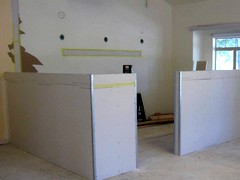
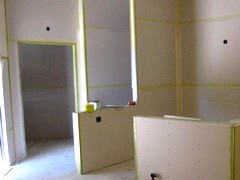
On the left you can see the infant crib area, and on the right is the toddler toilet area. Next come the plumbing and electrical inspections, then cabinets, painting, flooring. Furniture and materials are being shipped.
August 19, 2014
Dirt gone, underground plumbing
trenches filled, walls going up....
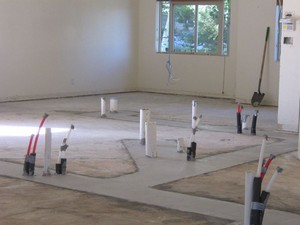

August 8, 2014
We knew a lot of plumbing was needed,
but....
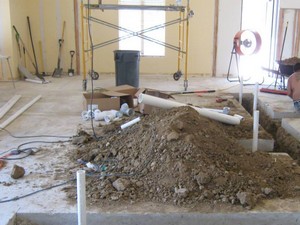
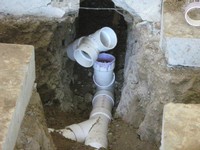
For 11 sinks and 3 toilets one must dig deep to make everything drain away. By next week this will all be filled in and closed up and we start making it look glorious! How soon we will forget what had to be done down below so that we can just take it for granted.
August 1, 2014
A Sign
of What Is To Come.

July 25, 2014
Out With the Old, In With the New.
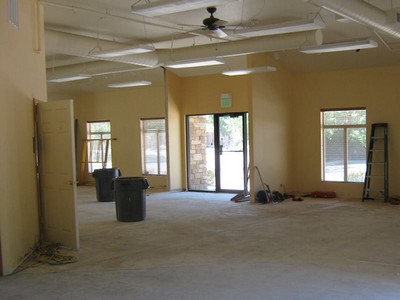 Here you see what it looks like after
clearing out existing walls. There's plenty of space now for the infant
room and the toddler room. New walls will start going up.
Here you see what it looks like after
clearing out existing walls. There's plenty of space now for the infant
room and the toddler room. New walls will start going up.
Infant-toddler centers need a lot of plumbing and that is one of the biggest parts
of the project. All this must happen "behind the scenes" in order to be
approved by the State, the County and the City. But more important, so
that we can have the kind of quality center we want and that the
community needs.
one of the biggest parts
of the project. All this must happen "behind the scenes" in order to be
approved by the State, the County and the City. But more important, so
that we can have the kind of quality center we want and that the
community needs.
July 20, 2014
Photos show where the new Montessori center will be. We are looking
forward to walks in the stroller and on
foot through the Forest Park behind the building.
July 8, 2014
Good Infant Centers Don't Grow On Trees !!
I have had the opportunity of working in a variety of Montessori settings, in the classroom and in administration. After 15 years I am excited to be opening up my own infant and toddler center, Heart and Hands Montessori. Together with my excellent staff, I will offer Boulder County the highest level of warm, gentle and respectful care for this age group.
First of all, the center is relatively small - two classrooms - so I can make sure everything is run right. Every child's needs are met, the staff is carefully chosen and supported, and the families are listened to, informed and pleased. This is an organic kind of process that is very difficult to have on a large scale. Large centers achieve economies of scale and make more money, but unfortunately they too often become bureaucratic, obsessive about efficiency, and less responsive to the individual needs of the children and families.
Even a small center must jump through a lot of hoops to become a reality. It took us quite awhile to find premises with enough space, natural light, trees and grass nearby. Then zoning had to be modified and architect's drawings refined. The State child care licensing authority saw the plans, came for a visit and gave provisional approval. The County Health Department's rules had to be followed in every little detail, and the Lafayette building department patiently explained all the building codes that apply.
As of this moment we are poised to hire a contractor, get the building permit, and begin the major overhaul of the space that not only meets all requirements but becomes a place the youngest children and their families love.
It will take only a matter of weeks. This blog will keep you informed of progress. Thanks for taking a few moments to keep up with our progress!
Susan Sears Smith,
Director of Heart and Hands Montessori
From the Montessori Academy of Denver, Colorado:
"We don't know what skills children will need for the future but surely the ability to learn, and develop character, values, self-image and the arts will be important."
Updated - May 25, 2015
